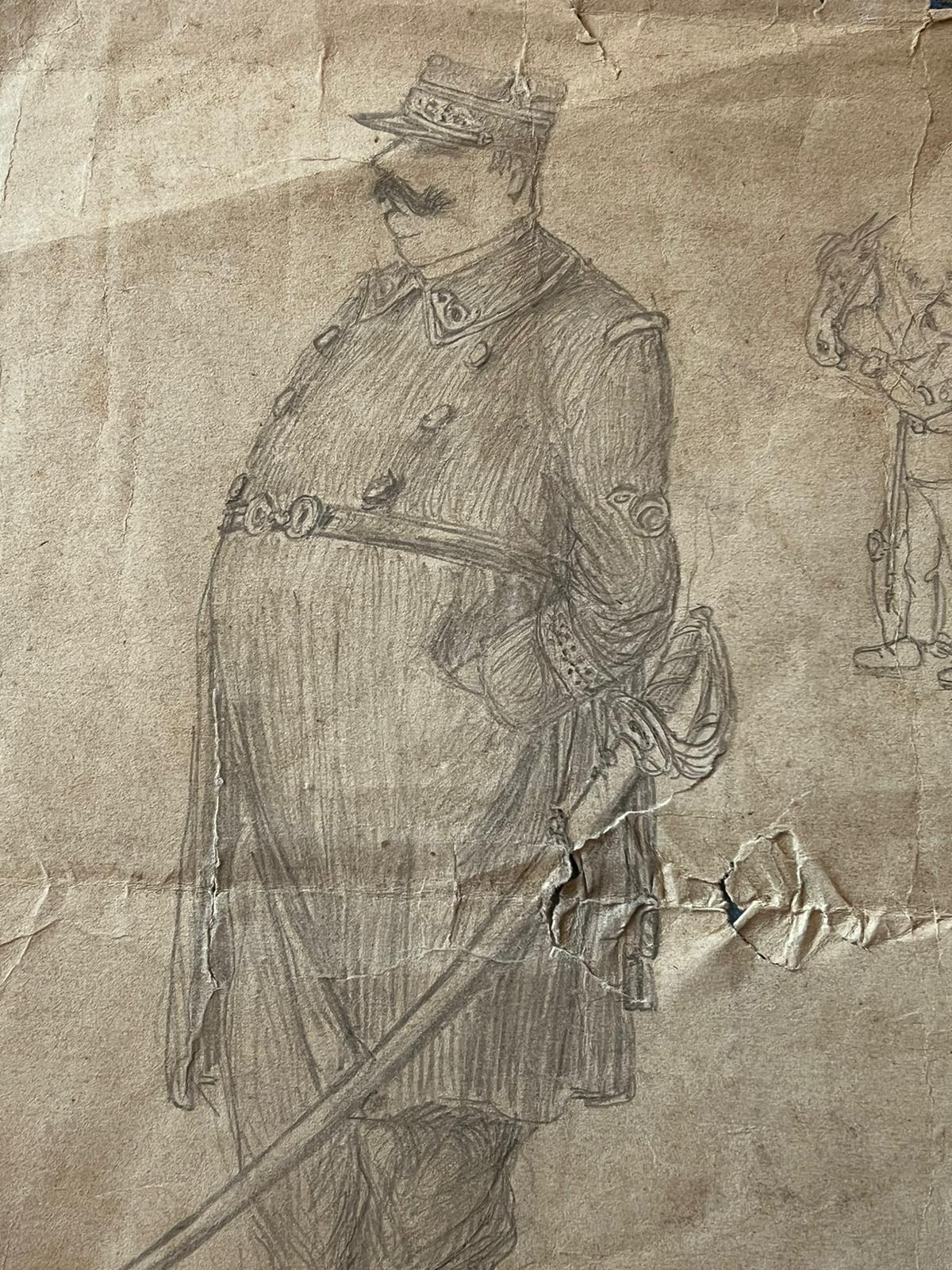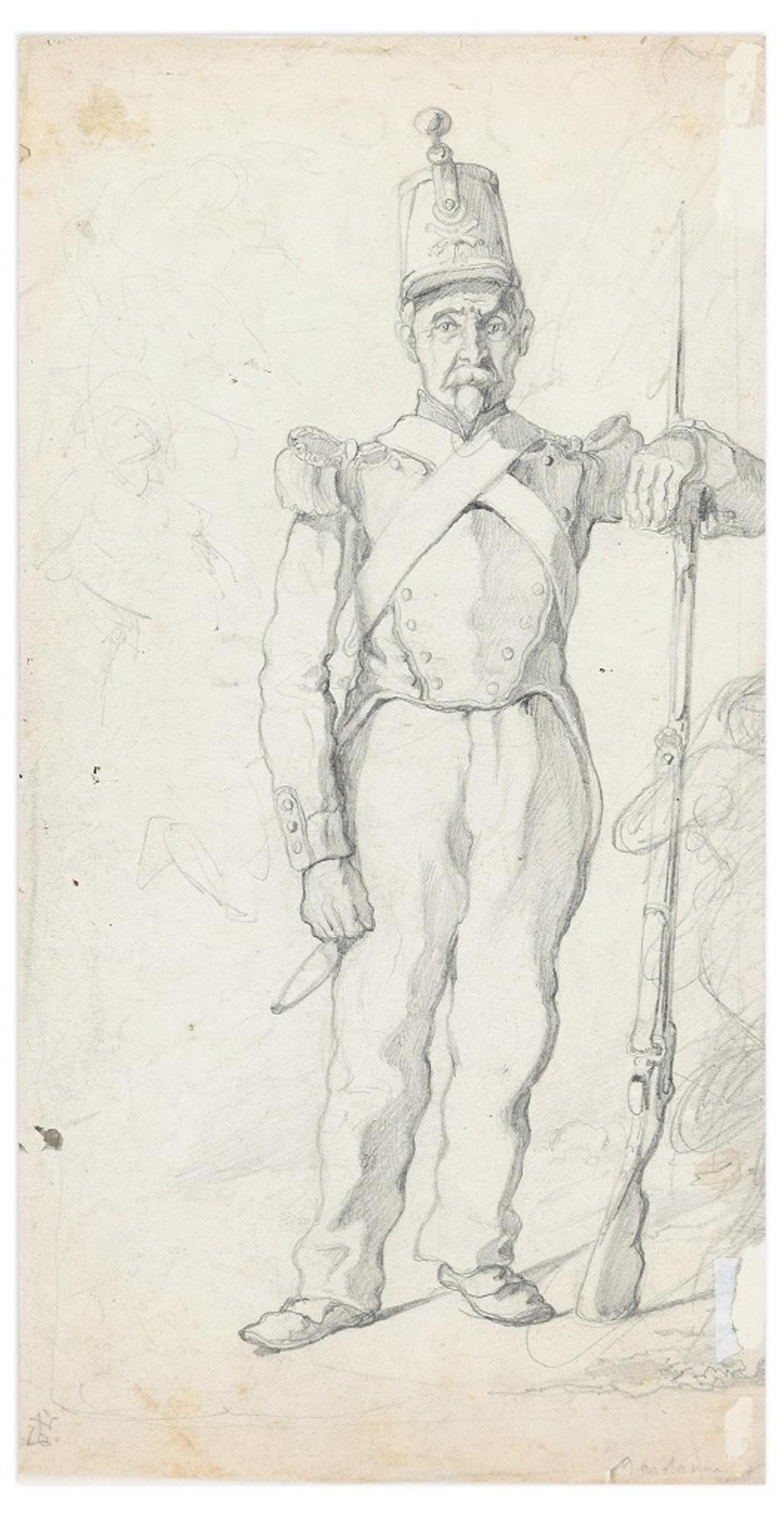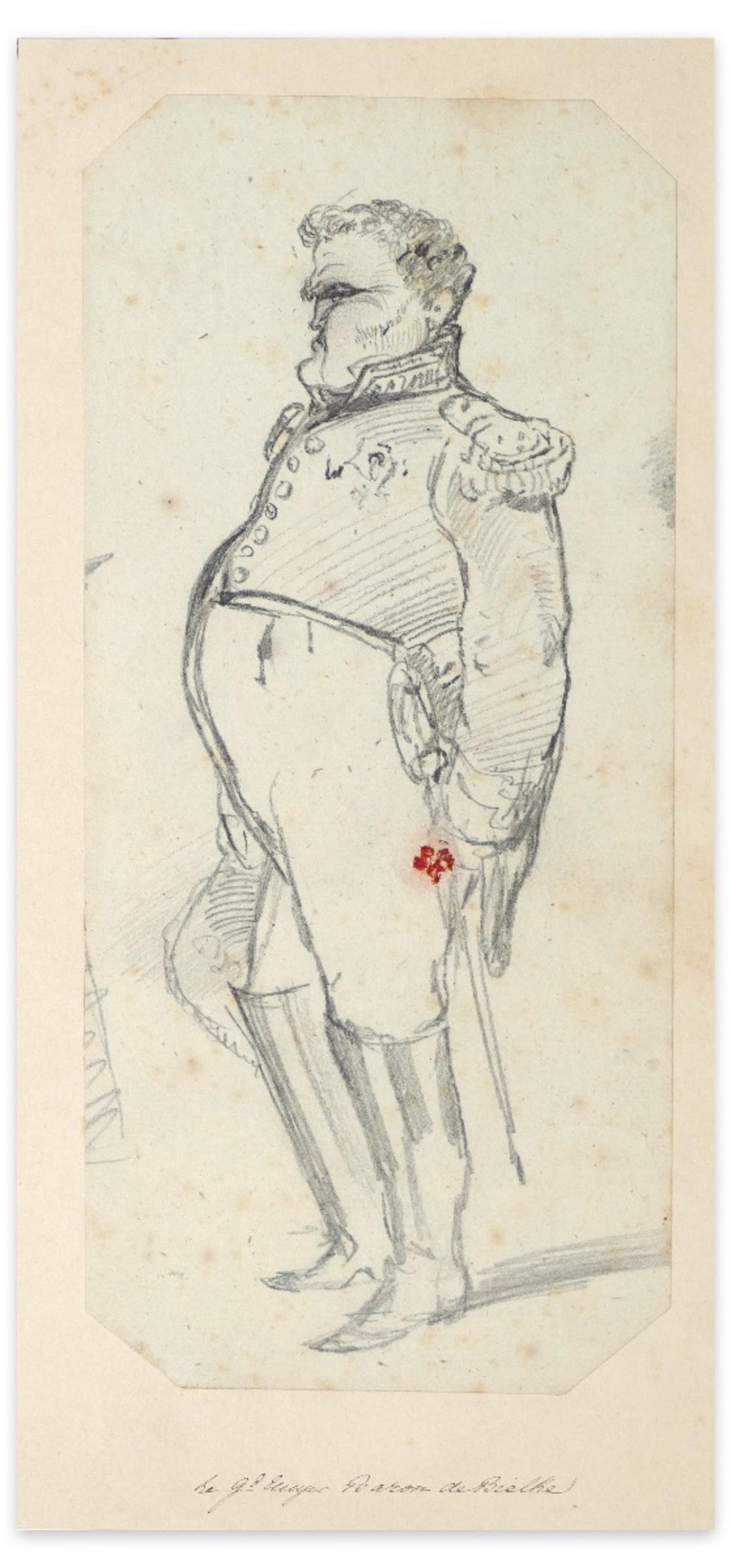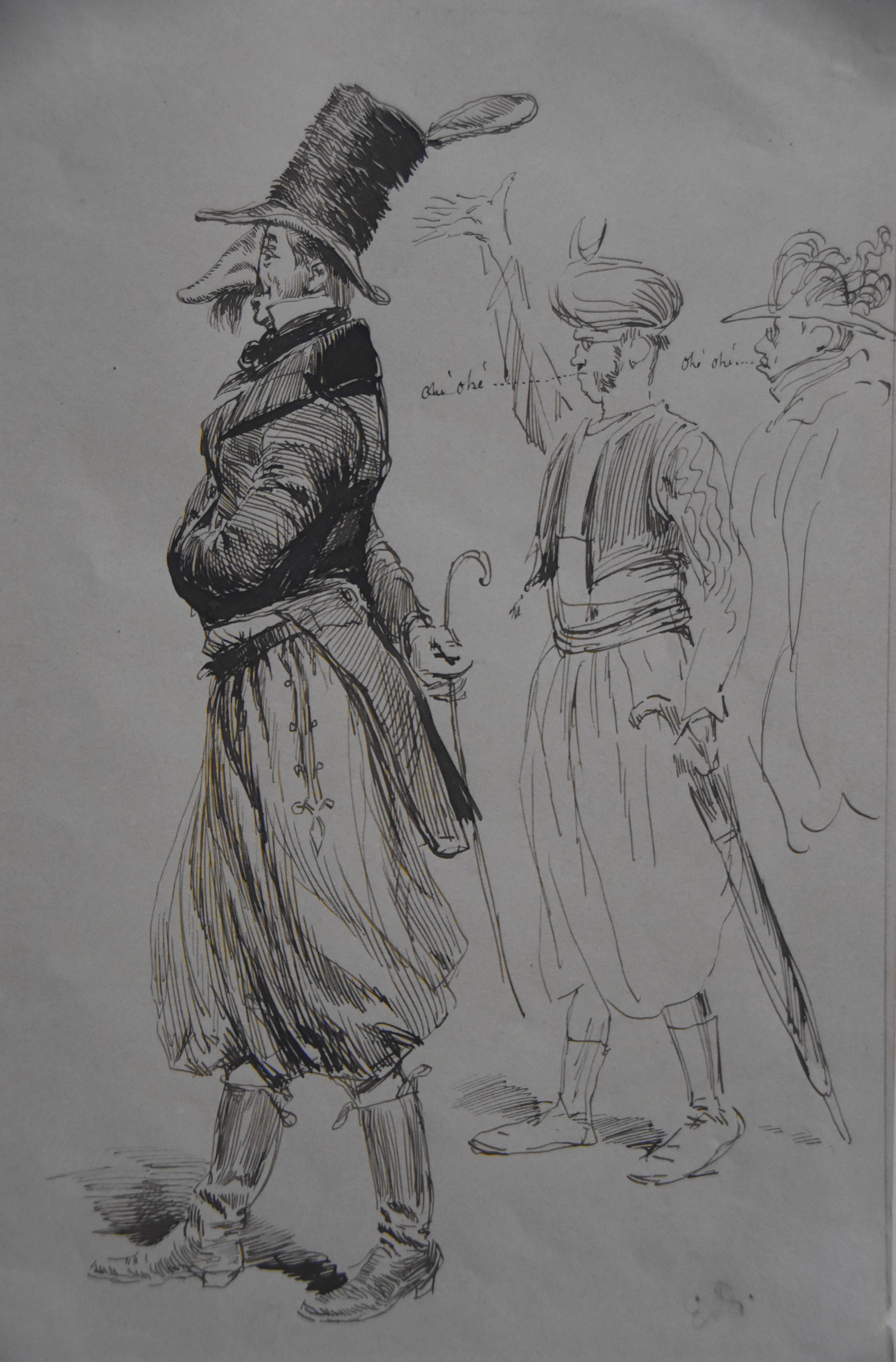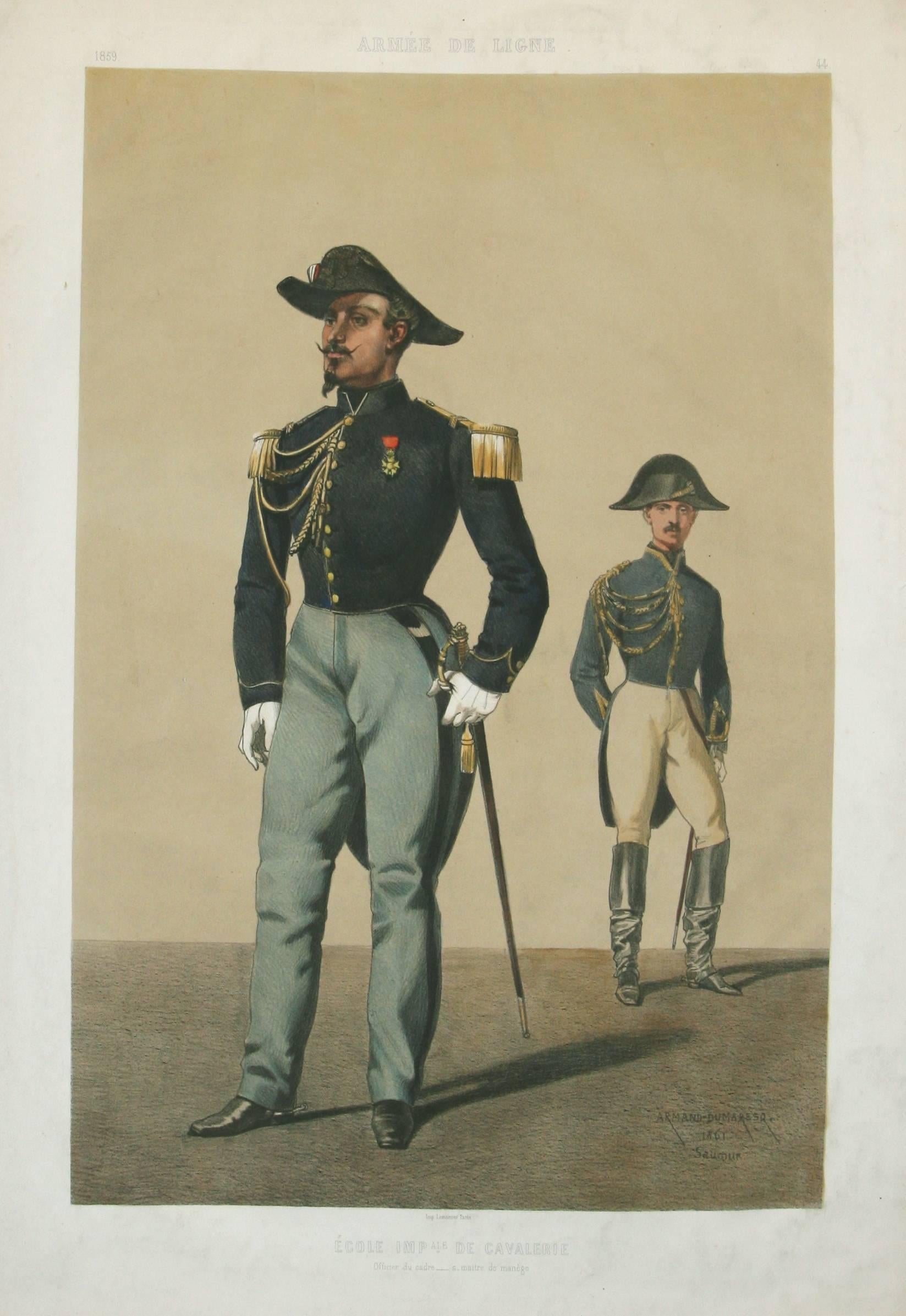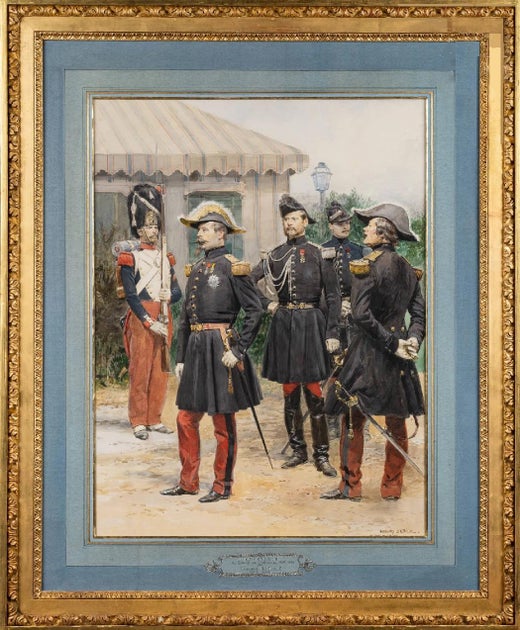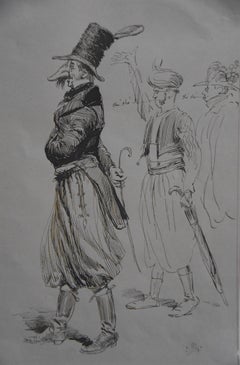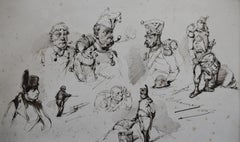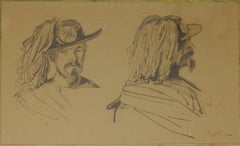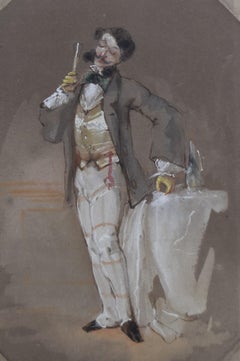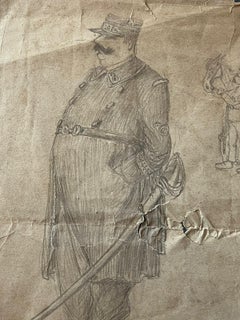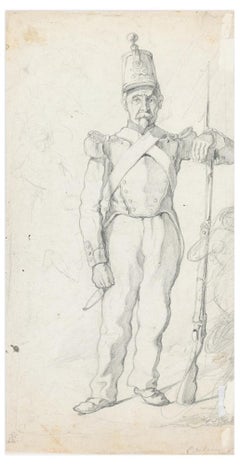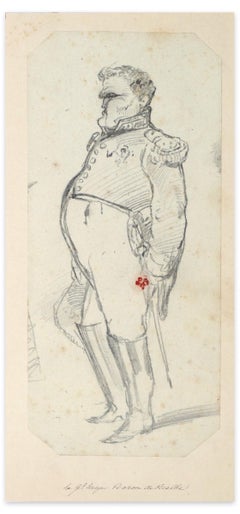Items Similar to Edouard Detaille (1848 1912) An officer of the Gendarmerie Impériale, drawing
Video Loading
Want more images or videos?
Request additional images or videos from the seller
1 of 13
Jean Baptiste Édouard DetailleEdouard Detaille (1848 1912) An officer of the Gendarmerie Impériale, drawingcirca 1880
circa 1880
$743.49
£553.08
€620
CA$1,018.09
A$1,131.98
CHF 591.06
MX$13,778.97
NOK 7,541.64
SEK 7,066.16
DKK 4,719.72
Shipping
Retrieving quote...The 1stDibs Promise:
Authenticity Guarantee,
Money-Back Guarantee,
24-Hour Cancellation
About the Item
Edouard Detaille (1848-1912)
An officer of the Gendarmerie Impériale, viewed of the back
bears the monogram ED but it is not visible because it is hidden by the mounting of the frame (see photographs taken out of the frame)
Pen and black ink on paper
23 x 15.5 cm (window)
Framed 38.5 x 31 cm
In this study of an officer on horseback, we can recognise an officer of the imperial gendarmerie, in particular by his very characteristic hat. Edouard Detaille's passion for military costumes, to which he devoted a large part of his work and which he collected, is well known.
Above all, he was a great draughtsman, as this study shows, combining his mastery of ink and pen with his sense of detail and realistic rendering.
Jean-Baptiste Édouard Detaille (Paris 5 October 1848 – 23 December 1912 Paris) was a French academic painter and military artist noted for his precision and realistic detail.
Detaille grew up in a prosperous military family in Picardy; his grandfather had been an arms supplier for Napoleon. An amateur artist who was friends with a number of collectors and painters, including Horace Vernet, Detaille's father encouraged his son's artistic endeavors. He began his artistic studies at age seventeen under the famous military painter Jean-Louis-Ernest Meissonier; he had originally approached him to ask for an introduction to the renowned Alexandre Cabanel but Meissonier decided to teach Detaille himself. Meissonier became a major influence on his style, and it was he who inculcated an appreciation for accuracy and precision in Detaille.
Detaille made his debut as an artist at the Salon—the official art exhibition of the Académie des Beaux-Arts—of 1867 with a painting of Meissonier's studio. At the Salon of 1868, he exhibited his first military painting, The Drummers Halt, which was based solely on his imagination of the French Revolution. With Repose During the Drill, Camp St Maur, which he debuted the following year, Detaille established his reputation as a painter. In the spring of 1870, he went on a "sketching trip" to Algeria with three other young painters, Étienne-Prosper Berne-Bellecour, Alexander Louis Leloir, and Jehan Georges Vibert.
Detaille enlisted in the 8th Mobile Bataillon of the French Army when the Franco-Prussian War broke out in 1870; by November he was seeing and experiencing the realities of war. This experience allowed him to produce his famed portraits of soldiers and historically accurate depictions of military manoeuvres, uniforms, and military life in general. He eventually became the official painter of the battles. He published a book called L'Armée Française in 1885, which contains over 300 line drawings and 20 color reproductions of his works.
Detaille was one of the first artists to buy photographs from Eugène Atget.
In 1912, Detaille created new uniforms for the French army. They were never adopted by the Minister of War, but the blue-gray greatcoats would influence later French World War I uniforms, and the Adrian helmet was heavily influenced by his designs.
During his life, he had amassed an impressive collection of military uniforms and artifacts and bequeathed to the Musée de l'Armée in Paris following his death.
Detaille appears as a guest at a party at the home of the Princesse de Guermantes in Part Two: Chapter One of Marcel Proust's novel, Cities of the Plain, where Detaille is referred to as "the creator of the Dream", his 1888 painting also known as Le Rêve (The Dream) which shows soldiers asleep on a battlefield dreaming of military glory. The painting, which is located at the Musée d'Orsay in Paris.
- Creator:Jean Baptiste Édouard Detaille (1848 - 1912, French)
- Creation Year:circa 1880
- Dimensions:Height: 9.06 in (23 cm)Width: 6.11 in (15.5 cm)
- Medium:
- Movement & Style:
- Period:
- Condition:
- Gallery Location:Paris, FR
- Reference Number:Seller: Inv 8111stDibs: LU1112215951312
Jean Baptiste Édouard Detaille
Jean-Baptiste Édouard Detaille (Paris 5 October 1848 – 23 December 1912 Paris) was a French academic painter and military artist noted for his precision and realistic detail. Detaille grew up in a prosperous military family in Picardy; his grandfather had been an arms supplier for Napoleon. An amateur artist who was friends with a number of collectors and painters, including Horace Vernet, Detaille's father encouraged his son's artistic endeavors. He began his artistic studies at age seventeen under the famous military painter Jean-Louis-Ernest Meissonier; he had originally approached him to ask for an introduction to the renowned Alexandre Cabanel but Meissonier decided to teach Detaille himself. Meissonier became a major influence on his style, and it was he who inculcated an appreciation for accuracy and precision in Detaille.
Detaille made his debut as an artist at the Salon—the official art exhibition of the Académie des Beaux-Arts—of 1867 with a painting of Meissonier's studio. At the Salon of 1868, he exhibited his first military painting, The Drummers Halt, which was based solely on his imagination of the French Revolution. With Repose During the Drill, Camp St Maur, which he debuted the following year, Detaille established his reputation as a painter. In the spring of 1870, he went on a "sketching trip" to Algeria with three other young painters, Étienne-Prosper Berne-Bellecour, Alexander Louis Leloir, and Jehan Georges Vibert.
Detaille enlisted in the 8th Mobile Bataillon of the French Army when the Franco-Prussian War broke out in 1870; by November he was seeing and experiencing the realities of war. This experience allowed him to produce his famed portraits of soldiers and historically accurate depictions of military manoeuvres, uniforms, and military life in general. He eventually became the official painter of the battles. He published a book called L'Armée Française in 1885, which contains over 300 line drawings and 20 color reproductions of his works. Detaille was one of the first artists to buy photographs from Eugène Atget.
In 1912, Detaille created new uniforms for the French army. They were never adopted by the Minister of War, but the blue-gray greatcoats would influence later French World War I uniforms, and the Adrian helmet was heavily influenced by his designs.
During his life, he had amassed an impressive collection of military uniforms and artifacts and bequeathed to the Musée de l'Armée in Paris following his death.
Detaille appears as a guest at a party at the home of the Princesse de Guermantes in Part Two: Chapter One of Marcel Proust's novel, Cities of the Plain, where Detaille is referred to as "the creator of the Dream", his 1888 painting also known as Le Rêve (The dream) which shows soldiers asleep on a battlefield dreaming of military glory. The painting, which is located at the Musée d'Orsay in Paris.
About the Seller
5.0
Gold Seller
Premium sellers maintaining a 4.3+ rating and 24-hour response times
Established in 2018
1stDibs seller since 2019
248 sales on 1stDibs
Typical response time: 2 hours
- ShippingRetrieving quote...Shipping from: Paris, France
- Return Policy
Authenticity Guarantee
In the unlikely event there’s an issue with an item’s authenticity, contact us within 1 year for a full refund. DetailsMoney-Back Guarantee
If your item is not as described, is damaged in transit, or does not arrive, contact us within 7 days for a full refund. Details24-Hour Cancellation
You have a 24-hour grace period in which to reconsider your purchase, with no questions asked.Vetted Professional Sellers
Our world-class sellers must adhere to strict standards for service and quality, maintaining the integrity of our listings.Price-Match Guarantee
If you find that a seller listed the same item for a lower price elsewhere, we’ll match it.Trusted Global Delivery
Our best-in-class carrier network provides specialized shipping options worldwide, including custom delivery.More From This Seller
View AllEdouard Detaille (1848 1912), A Carnival character, original signed Drawing
By Jean Baptiste Édouard Detaille
Located in Paris, FR
Edouard Detaille (1848-1912)
A Carnival character and a Zouave
19.5 x 12.5 cm
Pen and ink on paper
Signed lower left with the initials (faded)
In a modern framing : 35 x 28 cm
T...
Category
1880s Academic Figurative Drawings and Watercolors
Materials
Ink
Edouard Chevret (1835-1874), Napoleon and his soldiers, Studies, 1860, drawing
By Edouard Chevret
Located in Paris, FR
Edouard Chevret (1835-1864)
Napoleon and his soldiers, different studies
Signed on the lower right and dated 1860
28 x 45 cm
In a modern mount covering the original mount.
In quite g...
Category
1860s Portrait Drawings and Watercolors
Materials
Ink
Denis Auguste Raffet (1804-1860) Studies of a Tiroler Kaiserjäger, drawing
By Denis Auguste Marie Raffet
Located in Paris, FR
Denis Auguste Raffet (1804-1860)
Studies of a Tiroler Kaiserjäger,
Signed and dated 1849 lower right
Ink on paper
16.5 x 25.5 cm
In a nice period frame : 33 x 42 cm
Raffet had the occasion to draw studies of austrian soldiers as he took part as observer to the first Italian Independance War (1848-1849). It was the the first of many conflicts between the Kingdom of Sardinia , which later became the Kingdom of Italy , and the Austrian Empire.
The Kaiserjäger (imperial hunters) were founded in 1815 by Emperor Franz I. It was a great honor to enter the Kaiserjäger as they were the only ones to be honored with the term "imperial". However, only Tyrolese, Voralbergers and Welschtirolers were allowed.
They wore this characteristic hat as a parade headdress, it was made of matte black, waterproof felt. It consisted of a crown and brim adorned with a circular, green cord, the Jäger emblem and a plume of black rooster feathers. The hat cord was made of sheep's wool, and had a button and an acorn covered with a green wool.
These two studies clearly evoke the interest of the artist for this part of their uniform.
Denis Auguste Marie Raffet (2 March 1804 – 16 February 1860) was a French illustrator and lithographer. He was a student of Nicolas Toussaint Charlet, and was a retrospective painter of the Empire.
At an early age he was apprenticed to a wood turner, but took up the study of art at evening classes. At the age of 18 he entered the workshop of Cabanel, where he applied his skill to the decoration of china, and where he met Rudor, from whom he received instruction in lithography, in the practice of which he was to rise to fame. He then entered the École des Beaux-Arts, but returned to lithography in 1830 when he produced on stone his famous designs of Lützen, Waterloo, Le bal, La revue, and Les adieux de la garrison, by which his reputation became immediately established.
Raffet's chief works were his lithographs of the Napoleonic campaigns, from Egypt to Waterloo, vigorous designs inspired by ardent patriotic enthusiasm. In this endeavor he was a contemporary of other French artist-lithographers of Napoleon and the French army including Hippolyte Bellangé, Horace Vernet, and Nicolas Toussaint Charlet. As an illustrator his activity was prodigious, the list of works illustrated by his crayon amounting to about forty-five, among which are Béranger's poems, the History of the Revolution by Adolphe Thiers, the History of Napoleon by de Norvins, the great Walter Scott by Auguste Defauconpret, the French Plutarch and Frédéric Bérat's Songs.
He went to Rome in 1849, and was present at the siege of Rome, which he made the subject of some lithographs, and followed the Italian campaign of 1859, of which he left a record in his Episodes de la campagne d'Italie de 1859. His portraits in pencil...
Category
1840s Romantic Portrait Drawings and Watercolors
Materials
Ink
French School 19th Century, Portrait of a dandy, watercolor on paper
Located in Paris, FR
French School 19th Century,
Portrait of a dandy,
watercolor on paper
19 x 13 cm
Signed (?) with pencil lower right "L ... " illegible
Framed : 29 x 23 cm
Category
1880s Romantic Portrait Drawings and Watercolors
Materials
Watercolor
$277 Sale Price
30% Off
Edouard Detaille (1848 1912), The Young Paperboy, signed watercolor
By Jean Baptiste Édouard Detaille
Located in Paris, FR
Edouard Detaille (1848-1912)
The Young Paperboy
16.5 x 20.5 cm
Watercolor and brown ink on paper
Signed lower right
In good condition, the paper is slightly yellowed by time, some o...
Category
1880s Academic Figurative Drawings and Watercolors
Materials
Watercolor, Ink
Pierre-Georges Jeanniot (1848–1934), Henri Rochefort for a duel, drawing
By Pierre Georges Jeanniot
Located in Paris, FR
Pierre-Georges Jeanniot (1848–1934)
Portrait of Henri Rochefort ready for a duel,
Pencil on paper
Signed and titled lower left
28 x 21 cm
In good condition : the left and right borders irregularly cut
In a modern cardboard mount : 45.5 x 35 cm
Henri Rochefort, whose complete name was Victor Henri de Rochefort-Luçay , was born in Paris on January 31 , 1831, he died in Aix-les-Bains on 1 st July 1913. He was a french journalist , playwright and politician A great polemicist in the pages of his newspapers ( La Lanterne , La Marseillaise , L'Intransigeant), he defended radical and even extremist political options (anticlerical , nationalist , favorable to the Commune , Boulangist , socialist and anti-Dreyfusard ) which earned him the nickname of "The man with twenty duels and thirty trials », And convictions, in particular in the prison of Noumea from which, unique fact, he managed to escape in 1874.
Pierre-Georges Jeanniot (1848–1934) was a Swiss-French Impressionist painter, designer, watercolorist, and engraver who was born in Geneva, Switzerland, and died in France. His work often depicts the modern life in Paris.
He started out pursuing a military career, as an infantry officer (1866–1881). He was a lieutenant with the Twenty-third Infantry from 1868 to 1870. He fought in the Franco-Prussian War, was wounded at Rezonville, and was awarded the Légion d'Honneur. He subsequently served with the Ninety-fourth Infantry and the Seventy-third Infantry. At the time he left the army he held the rank of major, with the Chasseurs à Pieds.
He never ceased drawing. He was known for the first time in 1872 at the art exhibition Salon de Paris, where he presented a watercolor painting called Intérieur de forêt. The next year he presented the painting Le Vernan à Nass-sous-Sainte-Anne. From then on he was a regular contributor to the Salon de Paris, where he presented new works with views of Toulouse, Paris, Troyes, the edges of the Seine, and some portraits.
In 1881, after the army offered him the rank of commandant, he resigned to devote himself exclusively to painting. He took up residence in Paris. His works from this period represent mainly scenes of military life that allowed him to forge a reputation. Jeanniot established himself permanently in 1882 and obtained his first award the following year (medal third class of the Salon de Paris) with his les Flanqueurs (1883, Musée du Luxembourg). In 1886, La ligne de feu, souvenirs de la bataille de Rezonville, remembering the Battle of Mars-La-Tour (Museum of Pau), assured his notoriety.
From then on, he started to show a certain artistic independence. He then mostly portrayed Parisian women during the "Belle Epoque", women in bathing suits...
Category
1870s Romantic Portrait Drawings and Watercolors
Materials
Carbon Pencil
You May Also Like
Portrait of a Distinguished Military Officer in Uniform Sketch
Located in Cirencester, Gloucestershire
Portrait of a Distinguished Military Officer
pencil sketch on artist paper
painting: 11 x 8.5 inches
provenance: private collection
condition: good and sound condition - a few wear a...
Category
Mid-20th Century Modern Figurative Drawings and Watercolors
Materials
Color Pencil
Soldier - Original Pencil Drawing by an Unknown French Artist - 19th Century
Located in Roma, IT
Soldier is an original artwork realized by an Anonymous French artist in the first decades of the XIX Century.
Original pencil drawing. The sheet is drawed also on the back. Hand-s...
Category
19th Century Modern Figurative Drawings and Watercolors
Materials
Pencil
The General….Baron de Brielhe - Pencil by E. O. Wauquier - Mid-19th Century
By Etienne Omer Wauquier
Located in Roma, IT
The general ... Baron De Brielhe is an original drawing in pencil with gray point, unsigned, on paper, realized by E. O. Wauquier (1808-1869).
Good conditions except for minor cosme...
Category
Mid-19th Century Modern Figurative Drawings and Watercolors
Materials
Paper, Pencil
Military french painting 1870 war soldier horse Sketch 19th
Located in PARIS, FR
Alphonse de NEUVILLE
Saint-Omer, 1835 - Paris, 1885
Oil on wood panel
14.5 x 24 cm
Signed lower right
Alphonse de Neuville painted french soldiers during the war of 1870. For his wo...
Category
1870s French School Figurative Paintings
Materials
Oil
Ecole Imp.DE Cavalerie, Officier du Cadre Armee De Ligne pub. Lemercier 1861
By Édouard Armand-Dumaresq
Located in Paonia, CO
Ecole Imp.DE Cavalerie, Officier du Cadre shows two bearded French soldiers from the Armee De Ligne or the Line Army series. There is an officer in the foreground and a soldier...
Category
1860s Figurative Prints
Materials
Lithograph
Odry - Original Lithograph by Nicolas Toussaint Charlet - 1850s
Located in Roma, IT
Odry is an original lithograph realized by Nicolas Toussaint Charlet in 1850s.
Good condition, signature on the lower left corner.
Under the figure...
Category
Mid-20th Century Modern Figurative Prints
Materials
Lithograph
